Accounting Treatment of Intangible Assets: A Case Study of Telstra
VerifiedAdded on 2023/06/07
|12
|2824
|422
AI Summary
This report analyzes the accounting treatment of intangible assets by Telstra, a leading Australian company. It also discusses the current accounting framework of IFRS for the accounting treatment of intangible assets. The report provides recommendations for IASB and AASB to improve the accounting treatment of intangible assets.
Contribute Materials
Your contribution can guide someone’s learning journey. Share your
documents today.
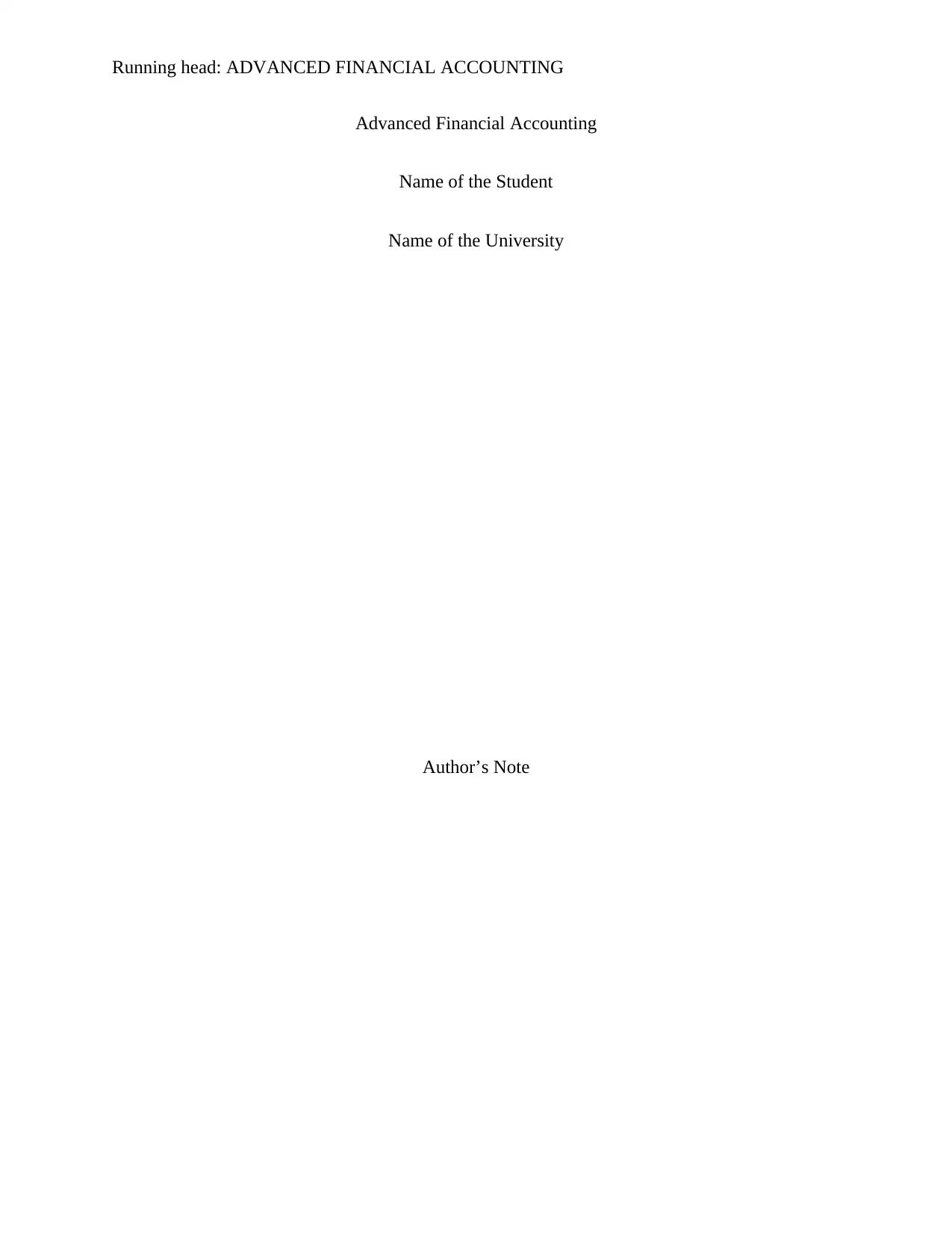
Running head: ADVANCED FINANCIAL ACCOUNTING
Advanced Financial Accounting
Name of the Student
Name of the University
Author’s Note
Advanced Financial Accounting
Name of the Student
Name of the University
Author’s Note
Secure Best Marks with AI Grader
Need help grading? Try our AI Grader for instant feedback on your assignments.

1ADVANCED FINANCIAL ACCOUNTING
Executive Summary
There are two parts in this report. The objective of the first part is the analysis of the intangible
asset treatment of a leading Australian company, Telstra; and the second part of this report sheds
light on the current accounting framework of IFRS for the accounting treatment of intangible
assets. It can be seen from the first part of the report that Telstra recognizes and measures part of
their intangible assets as per AASB 138 and another part by not complying with this standard. It
can also be seen that IASB has provided new framework for intangible assets through IAS 38
Intangible Assets.
Executive Summary
There are two parts in this report. The objective of the first part is the analysis of the intangible
asset treatment of a leading Australian company, Telstra; and the second part of this report sheds
light on the current accounting framework of IFRS for the accounting treatment of intangible
assets. It can be seen from the first part of the report that Telstra recognizes and measures part of
their intangible assets as per AASB 138 and another part by not complying with this standard. It
can also be seen that IASB has provided new framework for intangible assets through IAS 38
Intangible Assets.
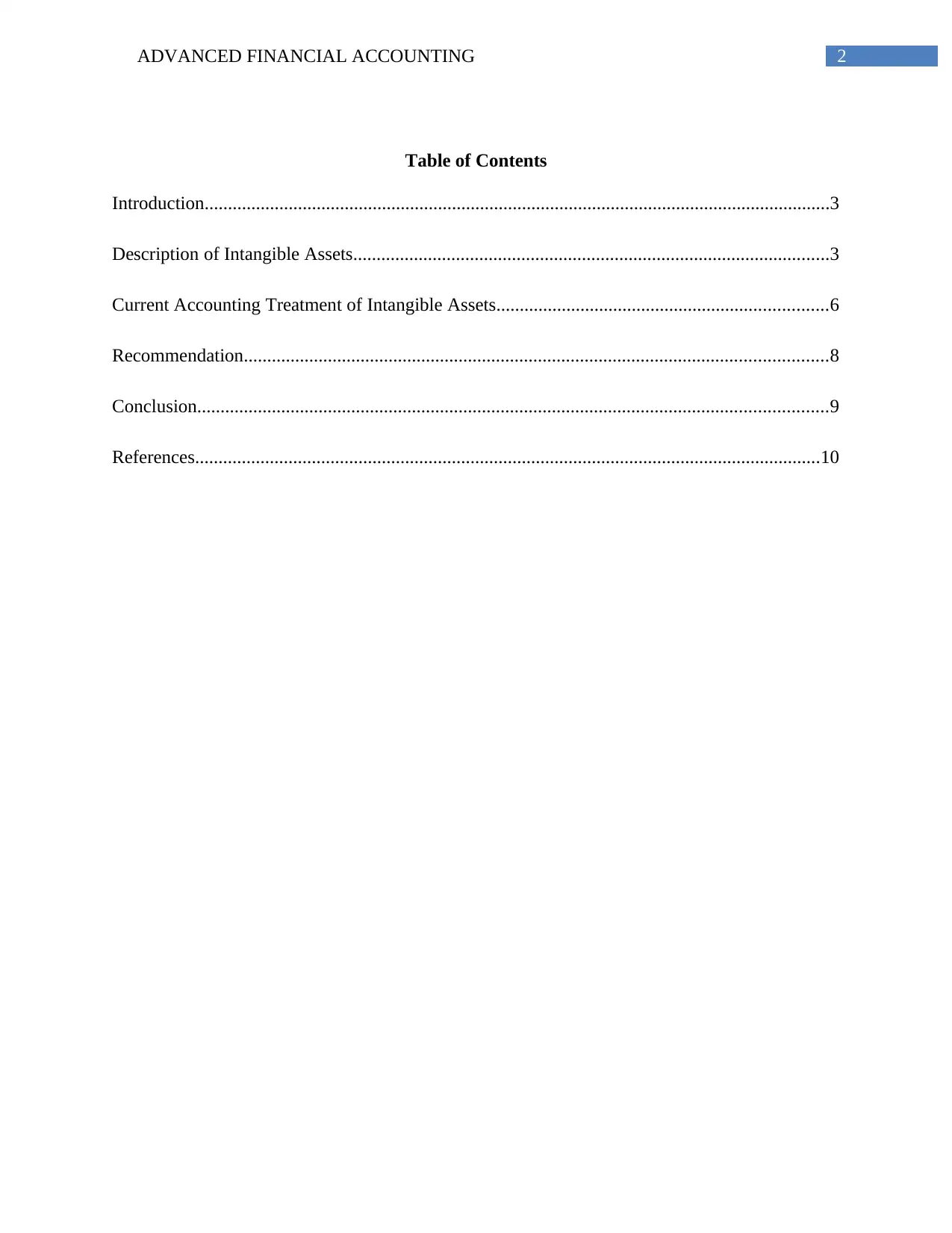
2ADVANCED FINANCIAL ACCOUNTING
Table of Contents
Introduction......................................................................................................................................3
Description of Intangible Assets......................................................................................................3
Current Accounting Treatment of Intangible Assets.......................................................................6
Recommendation.............................................................................................................................8
Conclusion.......................................................................................................................................9
References......................................................................................................................................10
Table of Contents
Introduction......................................................................................................................................3
Description of Intangible Assets......................................................................................................3
Current Accounting Treatment of Intangible Assets.......................................................................6
Recommendation.............................................................................................................................8
Conclusion.......................................................................................................................................9
References......................................................................................................................................10
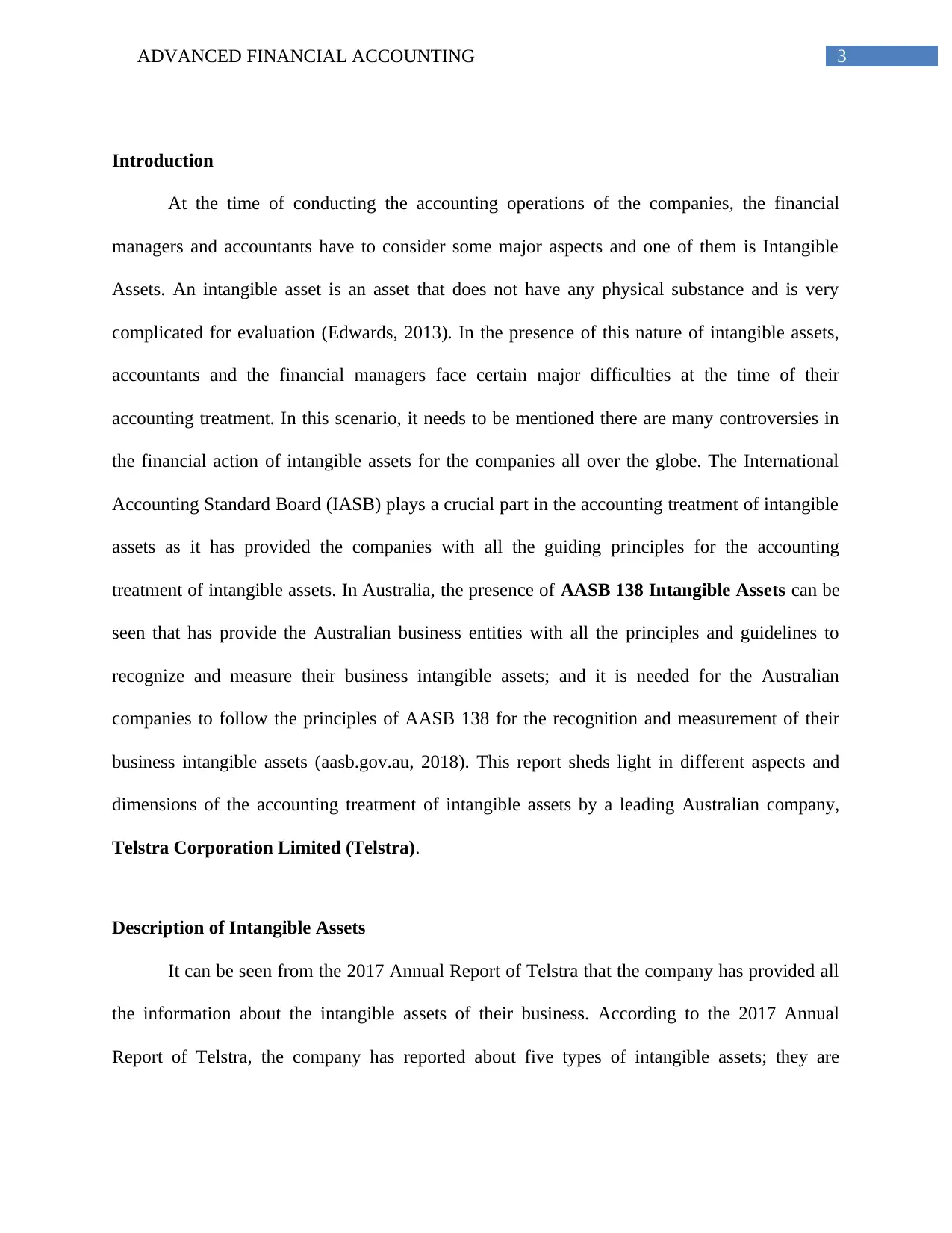
3ADVANCED FINANCIAL ACCOUNTING
Introduction
At the time of conducting the accounting operations of the companies, the financial
managers and accountants have to consider some major aspects and one of them is Intangible
Assets. An intangible asset is an asset that does not have any physical substance and is very
complicated for evaluation (Edwards, 2013). In the presence of this nature of intangible assets,
accountants and the financial managers face certain major difficulties at the time of their
accounting treatment. In this scenario, it needs to be mentioned there are many controversies in
the financial action of intangible assets for the companies all over the globe. The International
Accounting Standard Board (IASB) plays a crucial part in the accounting treatment of intangible
assets as it has provided the companies with all the guiding principles for the accounting
treatment of intangible assets. In Australia, the presence of AASB 138 Intangible Assets can be
seen that has provide the Australian business entities with all the principles and guidelines to
recognize and measure their business intangible assets; and it is needed for the Australian
companies to follow the principles of AASB 138 for the recognition and measurement of their
business intangible assets (aasb.gov.au, 2018). This report sheds light in different aspects and
dimensions of the accounting treatment of intangible assets by a leading Australian company,
Telstra Corporation Limited (Telstra).
Description of Intangible Assets
It can be seen from the 2017 Annual Report of Telstra that the company has provided all
the information about the intangible assets of their business. According to the 2017 Annual
Report of Telstra, the company has reported about five types of intangible assets; they are
Introduction
At the time of conducting the accounting operations of the companies, the financial
managers and accountants have to consider some major aspects and one of them is Intangible
Assets. An intangible asset is an asset that does not have any physical substance and is very
complicated for evaluation (Edwards, 2013). In the presence of this nature of intangible assets,
accountants and the financial managers face certain major difficulties at the time of their
accounting treatment. In this scenario, it needs to be mentioned there are many controversies in
the financial action of intangible assets for the companies all over the globe. The International
Accounting Standard Board (IASB) plays a crucial part in the accounting treatment of intangible
assets as it has provided the companies with all the guiding principles for the accounting
treatment of intangible assets. In Australia, the presence of AASB 138 Intangible Assets can be
seen that has provide the Australian business entities with all the principles and guidelines to
recognize and measure their business intangible assets; and it is needed for the Australian
companies to follow the principles of AASB 138 for the recognition and measurement of their
business intangible assets (aasb.gov.au, 2018). This report sheds light in different aspects and
dimensions of the accounting treatment of intangible assets by a leading Australian company,
Telstra Corporation Limited (Telstra).
Description of Intangible Assets
It can be seen from the 2017 Annual Report of Telstra that the company has provided all
the information about the intangible assets of their business. According to the 2017 Annual
Report of Telstra, the company has reported about five types of intangible assets; they are
Secure Best Marks with AI Grader
Need help grading? Try our AI Grader for instant feedback on your assignments.
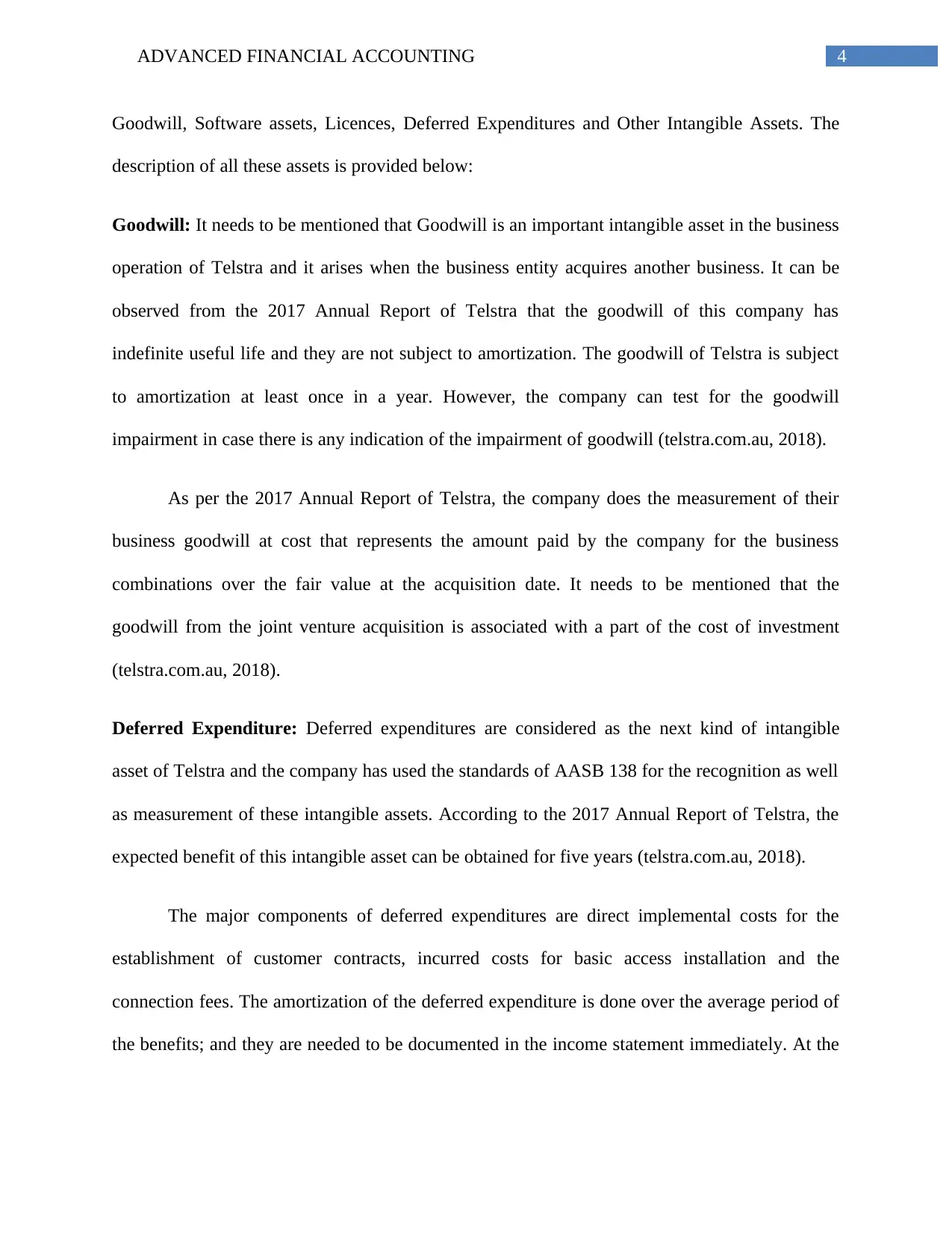
4ADVANCED FINANCIAL ACCOUNTING
Goodwill, Software assets, Licences, Deferred Expenditures and Other Intangible Assets. The
description of all these assets is provided below:
Goodwill: It needs to be mentioned that Goodwill is an important intangible asset in the business
operation of Telstra and it arises when the business entity acquires another business. It can be
observed from the 2017 Annual Report of Telstra that the goodwill of this company has
indefinite useful life and they are not subject to amortization. The goodwill of Telstra is subject
to amortization at least once in a year. However, the company can test for the goodwill
impairment in case there is any indication of the impairment of goodwill (telstra.com.au, 2018).
As per the 2017 Annual Report of Telstra, the company does the measurement of their
business goodwill at cost that represents the amount paid by the company for the business
combinations over the fair value at the acquisition date. It needs to be mentioned that the
goodwill from the joint venture acquisition is associated with a part of the cost of investment
(telstra.com.au, 2018).
Deferred Expenditure: Deferred expenditures are considered as the next kind of intangible
asset of Telstra and the company has used the standards of AASB 138 for the recognition as well
as measurement of these intangible assets. According to the 2017 Annual Report of Telstra, the
expected benefit of this intangible asset can be obtained for five years (telstra.com.au, 2018).
The major components of deferred expenditures are direct implemental costs for the
establishment of customer contracts, incurred costs for basic access installation and the
connection fees. The amortization of the deferred expenditure is done over the average period of
the benefits; and they are needed to be documented in the income statement immediately. At the
Goodwill, Software assets, Licences, Deferred Expenditures and Other Intangible Assets. The
description of all these assets is provided below:
Goodwill: It needs to be mentioned that Goodwill is an important intangible asset in the business
operation of Telstra and it arises when the business entity acquires another business. It can be
observed from the 2017 Annual Report of Telstra that the goodwill of this company has
indefinite useful life and they are not subject to amortization. The goodwill of Telstra is subject
to amortization at least once in a year. However, the company can test for the goodwill
impairment in case there is any indication of the impairment of goodwill (telstra.com.au, 2018).
As per the 2017 Annual Report of Telstra, the company does the measurement of their
business goodwill at cost that represents the amount paid by the company for the business
combinations over the fair value at the acquisition date. It needs to be mentioned that the
goodwill from the joint venture acquisition is associated with a part of the cost of investment
(telstra.com.au, 2018).
Deferred Expenditure: Deferred expenditures are considered as the next kind of intangible
asset of Telstra and the company has used the standards of AASB 138 for the recognition as well
as measurement of these intangible assets. According to the 2017 Annual Report of Telstra, the
expected benefit of this intangible asset can be obtained for five years (telstra.com.au, 2018).
The major components of deferred expenditures are direct implemental costs for the
establishment of customer contracts, incurred costs for basic access installation and the
connection fees. The amortization of the deferred expenditure is done over the average period of
the benefits; and they are needed to be documented in the income statement immediately. At the
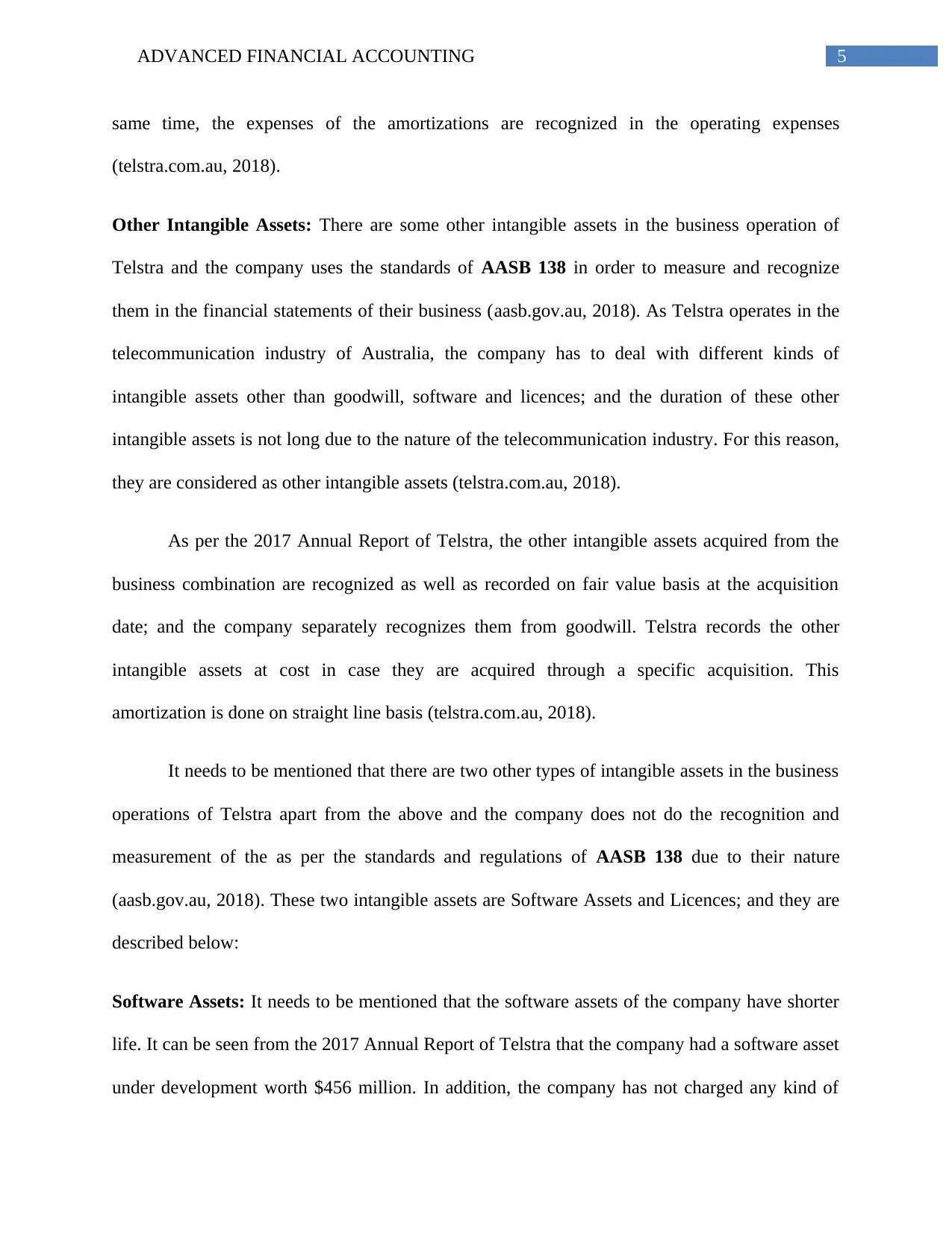
5ADVANCED FINANCIAL ACCOUNTING
same time, the expenses of the amortizations are recognized in the operating expenses
(telstra.com.au, 2018).
Other Intangible Assets: There are some other intangible assets in the business operation of
Telstra and the company uses the standards of AASB 138 in order to measure and recognize
them in the financial statements of their business (aasb.gov.au, 2018). As Telstra operates in the
telecommunication industry of Australia, the company has to deal with different kinds of
intangible assets other than goodwill, software and licences; and the duration of these other
intangible assets is not long due to the nature of the telecommunication industry. For this reason,
they are considered as other intangible assets (telstra.com.au, 2018).
As per the 2017 Annual Report of Telstra, the other intangible assets acquired from the
business combination are recognized as well as recorded on fair value basis at the acquisition
date; and the company separately recognizes them from goodwill. Telstra records the other
intangible assets at cost in case they are acquired through a specific acquisition. This
amortization is done on straight line basis (telstra.com.au, 2018).
It needs to be mentioned that there are two other types of intangible assets in the business
operations of Telstra apart from the above and the company does not do the recognition and
measurement of the as per the standards and regulations of AASB 138 due to their nature
(aasb.gov.au, 2018). These two intangible assets are Software Assets and Licences; and they are
described below:
Software Assets: It needs to be mentioned that the software assets of the company have shorter
life. It can be seen from the 2017 Annual Report of Telstra that the company had a software asset
under development worth $456 million. In addition, the company has not charged any kind of
same time, the expenses of the amortizations are recognized in the operating expenses
(telstra.com.au, 2018).
Other Intangible Assets: There are some other intangible assets in the business operation of
Telstra and the company uses the standards of AASB 138 in order to measure and recognize
them in the financial statements of their business (aasb.gov.au, 2018). As Telstra operates in the
telecommunication industry of Australia, the company has to deal with different kinds of
intangible assets other than goodwill, software and licences; and the duration of these other
intangible assets is not long due to the nature of the telecommunication industry. For this reason,
they are considered as other intangible assets (telstra.com.au, 2018).
As per the 2017 Annual Report of Telstra, the other intangible assets acquired from the
business combination are recognized as well as recorded on fair value basis at the acquisition
date; and the company separately recognizes them from goodwill. Telstra records the other
intangible assets at cost in case they are acquired through a specific acquisition. This
amortization is done on straight line basis (telstra.com.au, 2018).
It needs to be mentioned that there are two other types of intangible assets in the business
operations of Telstra apart from the above and the company does not do the recognition and
measurement of the as per the standards and regulations of AASB 138 due to their nature
(aasb.gov.au, 2018). These two intangible assets are Software Assets and Licences; and they are
described below:
Software Assets: It needs to be mentioned that the software assets of the company have shorter
life. It can be seen from the 2017 Annual Report of Telstra that the company had a software asset
under development worth $456 million. In addition, the company has not charged any kind of

6ADVANCED FINANCIAL ACCOUNTING
amortization of this asset as these assets were not installed and ready. It can also be observed
from the 2017 Annual Report of Telstra that the software assets include capitalized borrowings
worth $27 million that is directly attributed towards the qualifying assets (telstra.com.au, 2018).
Licences: Licences are regarded as another type of intangible assets in Telstra and the company
has not recognized as well as measured as per the regulations and standards of AASB 138
(aasb.gov.au, 2018). As per the 2017 Annual Report, the benefit from the licences can be
obtained for fourteen years. It needs to be mentioned that the government of Australia grants
Telstra licences for the dedicated use of the portions of spectrums. In the current financial 2017,
Telstra has acquired licences for 1800 MHz and 2.5 GHz spectrum for their telecommunication
business (telstra.com.au, 2018).
Current Accounting Treatment of Intangible Assets
International Financial Reporting Standards (IFRS) has given the business entities with
the needed principles for the financial treatments of intangible assets through IAS 38 Intangible
Assets. The following discussion shows the accounting treatment of intangible assets under IAS
38.
Objective: The main objective of IAS 38 is the prescription of the accounting actions for the
intangible assets that another IAS standard does not deal. As per the requirement of this standard,
companies are needed to recognize the intangible assets after meeting the criteria. It provides the
companies with the guidelines for the accounting treatment of intangible assets (iasplus.com,
2018).
amortization of this asset as these assets were not installed and ready. It can also be observed
from the 2017 Annual Report of Telstra that the software assets include capitalized borrowings
worth $27 million that is directly attributed towards the qualifying assets (telstra.com.au, 2018).
Licences: Licences are regarded as another type of intangible assets in Telstra and the company
has not recognized as well as measured as per the regulations and standards of AASB 138
(aasb.gov.au, 2018). As per the 2017 Annual Report, the benefit from the licences can be
obtained for fourteen years. It needs to be mentioned that the government of Australia grants
Telstra licences for the dedicated use of the portions of spectrums. In the current financial 2017,
Telstra has acquired licences for 1800 MHz and 2.5 GHz spectrum for their telecommunication
business (telstra.com.au, 2018).
Current Accounting Treatment of Intangible Assets
International Financial Reporting Standards (IFRS) has given the business entities with
the needed principles for the financial treatments of intangible assets through IAS 38 Intangible
Assets. The following discussion shows the accounting treatment of intangible assets under IAS
38.
Objective: The main objective of IAS 38 is the prescription of the accounting actions for the
intangible assets that another IAS standard does not deal. As per the requirement of this standard,
companies are needed to recognize the intangible assets after meeting the criteria. It provides the
companies with the guidelines for the accounting treatment of intangible assets (iasplus.com,
2018).
Paraphrase This Document
Need a fresh take? Get an instant paraphrase of this document with our AI Paraphraser
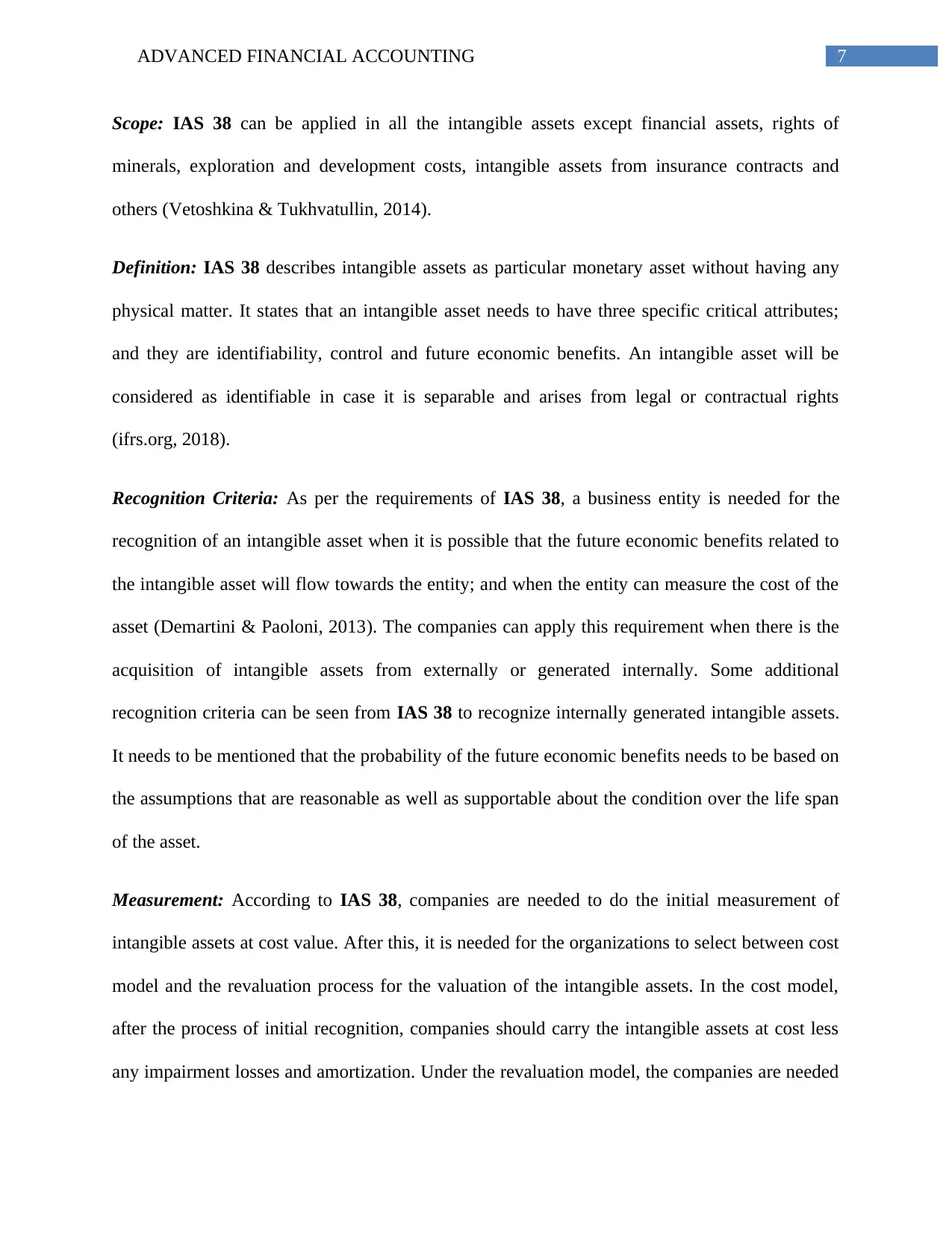
7ADVANCED FINANCIAL ACCOUNTING
Scope: IAS 38 can be applied in all the intangible assets except financial assets, rights of
minerals, exploration and development costs, intangible assets from insurance contracts and
others (Vetoshkina & Tukhvatullin, 2014).
Definition: IAS 38 describes intangible assets as particular monetary asset without having any
physical matter. It states that an intangible asset needs to have three specific critical attributes;
and they are identifiability, control and future economic benefits. An intangible asset will be
considered as identifiable in case it is separable and arises from legal or contractual rights
(ifrs.org, 2018).
Recognition Criteria: As per the requirements of IAS 38, a business entity is needed for the
recognition of an intangible asset when it is possible that the future economic benefits related to
the intangible asset will flow towards the entity; and when the entity can measure the cost of the
asset (Demartini & Paoloni, 2013). The companies can apply this requirement when there is the
acquisition of intangible assets from externally or generated internally. Some additional
recognition criteria can be seen from IAS 38 to recognize internally generated intangible assets.
It needs to be mentioned that the probability of the future economic benefits needs to be based on
the assumptions that are reasonable as well as supportable about the condition over the life span
of the asset.
Measurement: According to IAS 38, companies are needed to do the initial measurement of
intangible assets at cost value. After this, it is needed for the organizations to select between cost
model and the revaluation process for the valuation of the intangible assets. In the cost model,
after the process of initial recognition, companies should carry the intangible assets at cost less
any impairment losses and amortization. Under the revaluation model, the companies are needed
Scope: IAS 38 can be applied in all the intangible assets except financial assets, rights of
minerals, exploration and development costs, intangible assets from insurance contracts and
others (Vetoshkina & Tukhvatullin, 2014).
Definition: IAS 38 describes intangible assets as particular monetary asset without having any
physical matter. It states that an intangible asset needs to have three specific critical attributes;
and they are identifiability, control and future economic benefits. An intangible asset will be
considered as identifiable in case it is separable and arises from legal or contractual rights
(ifrs.org, 2018).
Recognition Criteria: As per the requirements of IAS 38, a business entity is needed for the
recognition of an intangible asset when it is possible that the future economic benefits related to
the intangible asset will flow towards the entity; and when the entity can measure the cost of the
asset (Demartini & Paoloni, 2013). The companies can apply this requirement when there is the
acquisition of intangible assets from externally or generated internally. Some additional
recognition criteria can be seen from IAS 38 to recognize internally generated intangible assets.
It needs to be mentioned that the probability of the future economic benefits needs to be based on
the assumptions that are reasonable as well as supportable about the condition over the life span
of the asset.
Measurement: According to IAS 38, companies are needed to do the initial measurement of
intangible assets at cost value. After this, it is needed for the organizations to select between cost
model and the revaluation process for the valuation of the intangible assets. In the cost model,
after the process of initial recognition, companies should carry the intangible assets at cost less
any impairment losses and amortization. Under the revaluation model, the companies are needed

8ADVANCED FINANCIAL ACCOUNTING
to carry the intangible assets at revalued amount less any subsequent amortization and
impairment losses where the fair value can be determined in the active market (Dinh et al.,
2015).
Objectives, Users and Qualitative Characteristics of General Purpose Financial Reporting: As
per IASB and IFRS, the main objective of general purpose financial reporting (GPFR) is to give
the investors, lenders and other creditors with the required financial information in order to make
decisions about the entity’s resources. From this perspective, the success of IAS 38 can be seen
in the companies as this standard helps the companies in disclosing the required information
about their intangible assets so that the users like investors, creditors and lenders can use them
for judging the financial standing of the company (Dinh et al., 2015). Relevance and faithful
representation are the two fundamental qualitative characteristics of financial information. It
needs to be mentioned that the compliance with IAS 38 makes the intangible asset related
information of the companies relevant as it provides the recent information; moreover,
compliance with this standard ensures that the information is faithfully represented to the
primary users of the financial statements. Moreover, the regulations of IAS 38 ensure that the
financial information related to intangible assets includes the enhancing qualitative
characteristics like comparability, timeliness, verifiability and understandability (ey.com, 2018).
The presence of these characteristics helps in enhancing the quality of the financial information.
Recommendation
Based on the above discussion, the necessary recommendations are provide below:
o It needs to be mentioned that there is a chance of the increase in the amount of the
intangible assets in the statement of financial position of the business entities in case the
to carry the intangible assets at revalued amount less any subsequent amortization and
impairment losses where the fair value can be determined in the active market (Dinh et al.,
2015).
Objectives, Users and Qualitative Characteristics of General Purpose Financial Reporting: As
per IASB and IFRS, the main objective of general purpose financial reporting (GPFR) is to give
the investors, lenders and other creditors with the required financial information in order to make
decisions about the entity’s resources. From this perspective, the success of IAS 38 can be seen
in the companies as this standard helps the companies in disclosing the required information
about their intangible assets so that the users like investors, creditors and lenders can use them
for judging the financial standing of the company (Dinh et al., 2015). Relevance and faithful
representation are the two fundamental qualitative characteristics of financial information. It
needs to be mentioned that the compliance with IAS 38 makes the intangible asset related
information of the companies relevant as it provides the recent information; moreover,
compliance with this standard ensures that the information is faithfully represented to the
primary users of the financial statements. Moreover, the regulations of IAS 38 ensure that the
financial information related to intangible assets includes the enhancing qualitative
characteristics like comparability, timeliness, verifiability and understandability (ey.com, 2018).
The presence of these characteristics helps in enhancing the quality of the financial information.
Recommendation
Based on the above discussion, the necessary recommendations are provide below:
o It needs to be mentioned that there is a chance of the increase in the amount of the
intangible assets in the statement of financial position of the business entities in case the

9ADVANCED FINANCIAL ACCOUNTING
purchase of mote intangible assets; like trademarks and others. For this reason, it is not
possible for IAS 38 to do the valuation of these intangible assets. This can lead to
inconsistencies. In order to avoid this situation, it is needed for IAS 38 to allow the
revaluation of these intangible assets to include the value of the additional intangible
assets in the required financial statements (Carvalho, Rodrigues & Ferreira, 2016).
o It is recommended to IASB and Australian Accounting Standard Board (AASB) to allow
some intangible assets with identifiable useful life to be included in the goodwill. More
specifically, it is recommended to IASB and AASB to allow the intangible assets having
identifiable useful life to be included with the goodwill, in case those assets are not
generating from the use of continuing independent cash flow. There is also scope for
IASB and AASB for requiring the qualitative disclosures for any identifiable intangible
asset having indefinite useful life within the goodwill (Yallwe & Buscemi, 2014).
Conclusion
The report involves in the analysis and evaluation of the accounting of intangible assets
of Telstra. The discussion shows that Telstra does the accounting treatment of some of their
intangible asset as per the standard of AASB 138 Intangible Assets like goodwill, other
intangible assets and others; while the company carries the accounting treatment of some of their
intangible asset by not complying with the standards of AASB 138 Intangible Assets like
software assets and licenses. The above discussion also sheds light in the present accounting
treatment of intangible assets by IFRS with the help of the standard of IAS 38 Intangible Assets.
Under this regulation, the business entities are needed to recognize as well as measure the
intangible assets as per the regulations of ASA 38 Intangible Assets. The critical evaluation part
shows that this new regulation of IFRS complies with the objective of GPFR and contains the
purchase of mote intangible assets; like trademarks and others. For this reason, it is not
possible for IAS 38 to do the valuation of these intangible assets. This can lead to
inconsistencies. In order to avoid this situation, it is needed for IAS 38 to allow the
revaluation of these intangible assets to include the value of the additional intangible
assets in the required financial statements (Carvalho, Rodrigues & Ferreira, 2016).
o It is recommended to IASB and Australian Accounting Standard Board (AASB) to allow
some intangible assets with identifiable useful life to be included in the goodwill. More
specifically, it is recommended to IASB and AASB to allow the intangible assets having
identifiable useful life to be included with the goodwill, in case those assets are not
generating from the use of continuing independent cash flow. There is also scope for
IASB and AASB for requiring the qualitative disclosures for any identifiable intangible
asset having indefinite useful life within the goodwill (Yallwe & Buscemi, 2014).
Conclusion
The report involves in the analysis and evaluation of the accounting of intangible assets
of Telstra. The discussion shows that Telstra does the accounting treatment of some of their
intangible asset as per the standard of AASB 138 Intangible Assets like goodwill, other
intangible assets and others; while the company carries the accounting treatment of some of their
intangible asset by not complying with the standards of AASB 138 Intangible Assets like
software assets and licenses. The above discussion also sheds light in the present accounting
treatment of intangible assets by IFRS with the help of the standard of IAS 38 Intangible Assets.
Under this regulation, the business entities are needed to recognize as well as measure the
intangible assets as per the regulations of ASA 38 Intangible Assets. The critical evaluation part
shows that this new regulation of IFRS complies with the objective of GPFR and contains the
Secure Best Marks with AI Grader
Need help grading? Try our AI Grader for instant feedback on your assignments.
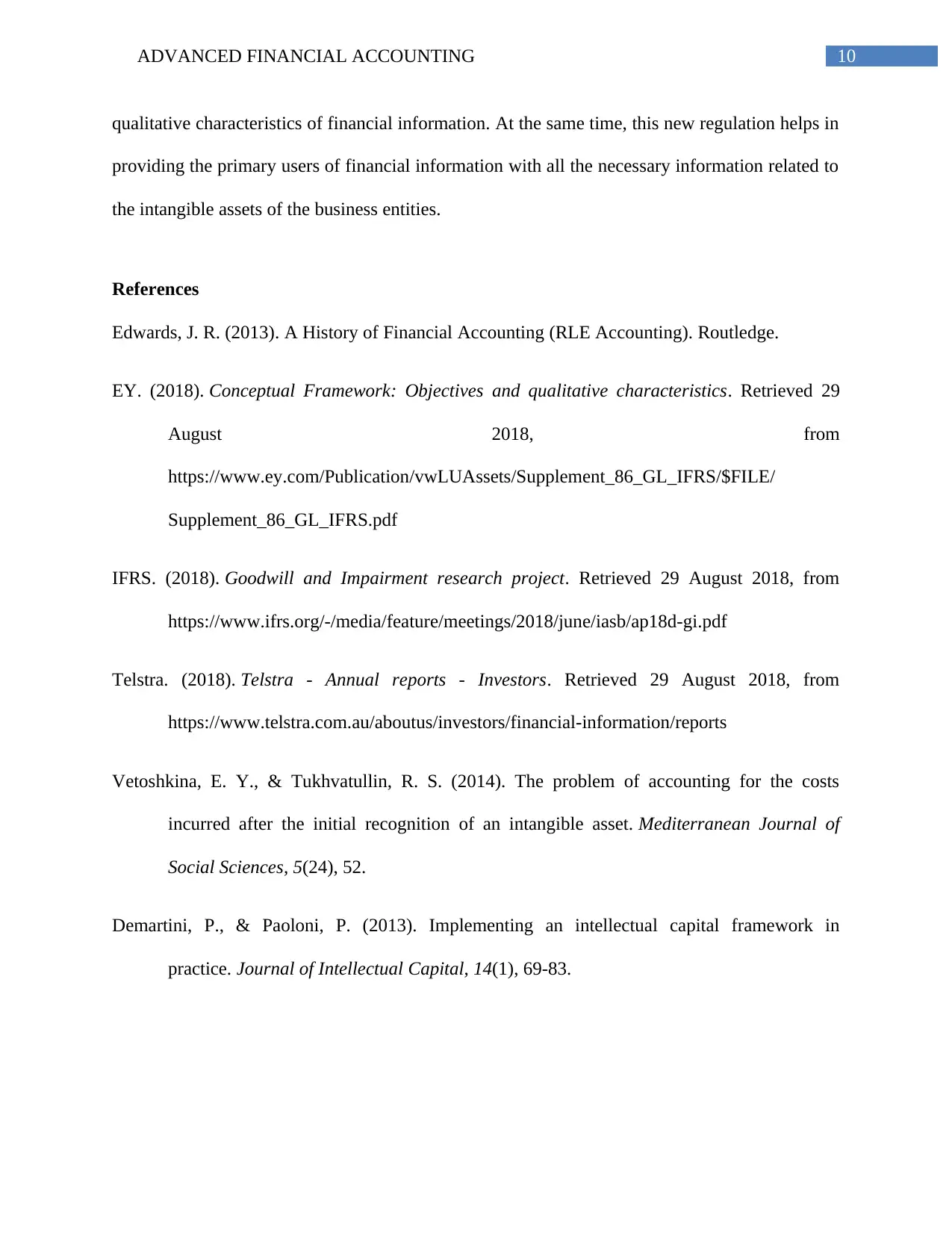
10ADVANCED FINANCIAL ACCOUNTING
qualitative characteristics of financial information. At the same time, this new regulation helps in
providing the primary users of financial information with all the necessary information related to
the intangible assets of the business entities.
References
Edwards, J. R. (2013). A History of Financial Accounting (RLE Accounting). Routledge.
EY. (2018). Conceptual Framework: Objectives and qualitative characteristics. Retrieved 29
August 2018, from
https://www.ey.com/Publication/vwLUAssets/Supplement_86_GL_IFRS/$FILE/
Supplement_86_GL_IFRS.pdf
IFRS. (2018). Goodwill and Impairment research project. Retrieved 29 August 2018, from
https://www.ifrs.org/-/media/feature/meetings/2018/june/iasb/ap18d-gi.pdf
Telstra. (2018). Telstra - Annual reports - Investors. Retrieved 29 August 2018, from
https://www.telstra.com.au/aboutus/investors/financial-information/reports
Vetoshkina, E. Y., & Tukhvatullin, R. S. (2014). The problem of accounting for the costs
incurred after the initial recognition of an intangible asset. Mediterranean Journal of
Social Sciences, 5(24), 52.
Demartini, P., & Paoloni, P. (2013). Implementing an intellectual capital framework in
practice. Journal of Intellectual Capital, 14(1), 69-83.
qualitative characteristics of financial information. At the same time, this new regulation helps in
providing the primary users of financial information with all the necessary information related to
the intangible assets of the business entities.
References
Edwards, J. R. (2013). A History of Financial Accounting (RLE Accounting). Routledge.
EY. (2018). Conceptual Framework: Objectives and qualitative characteristics. Retrieved 29
August 2018, from
https://www.ey.com/Publication/vwLUAssets/Supplement_86_GL_IFRS/$FILE/
Supplement_86_GL_IFRS.pdf
IFRS. (2018). Goodwill and Impairment research project. Retrieved 29 August 2018, from
https://www.ifrs.org/-/media/feature/meetings/2018/june/iasb/ap18d-gi.pdf
Telstra. (2018). Telstra - Annual reports - Investors. Retrieved 29 August 2018, from
https://www.telstra.com.au/aboutus/investors/financial-information/reports
Vetoshkina, E. Y., & Tukhvatullin, R. S. (2014). The problem of accounting for the costs
incurred after the initial recognition of an intangible asset. Mediterranean Journal of
Social Sciences, 5(24), 52.
Demartini, P., & Paoloni, P. (2013). Implementing an intellectual capital framework in
practice. Journal of Intellectual Capital, 14(1), 69-83.
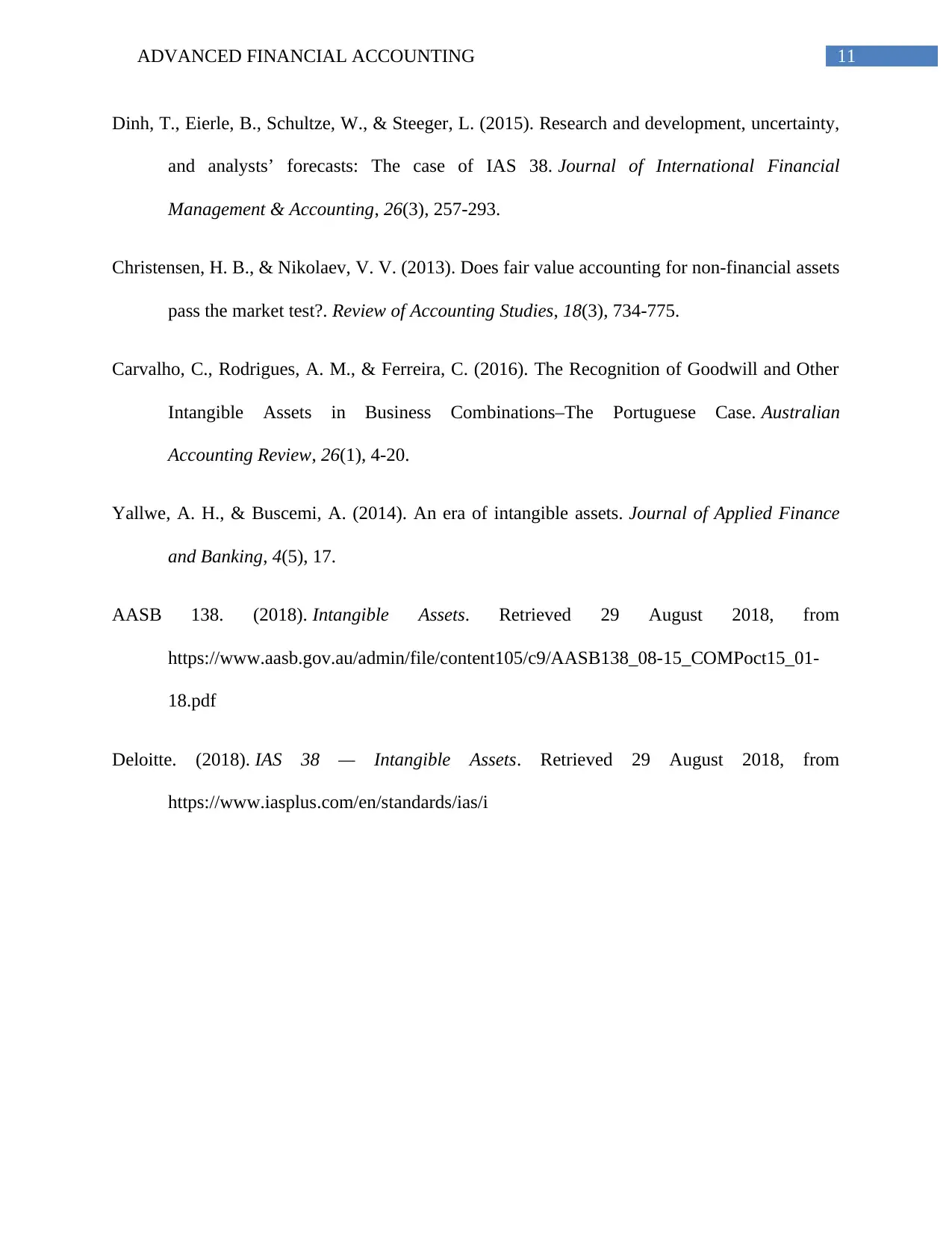
11ADVANCED FINANCIAL ACCOUNTING
Dinh, T., Eierle, B., Schultze, W., & Steeger, L. (2015). Research and development, uncertainty,
and analysts’ forecasts: The case of IAS 38. Journal of International Financial
Management & Accounting, 26(3), 257-293.
Christensen, H. B., & Nikolaev, V. V. (2013). Does fair value accounting for non-financial assets
pass the market test?. Review of Accounting Studies, 18(3), 734-775.
Carvalho, C., Rodrigues, A. M., & Ferreira, C. (2016). The Recognition of Goodwill and Other
Intangible Assets in Business Combinations–The Portuguese Case. Australian
Accounting Review, 26(1), 4-20.
Yallwe, A. H., & Buscemi, A. (2014). An era of intangible assets. Journal of Applied Finance
and Banking, 4(5), 17.
AASB 138. (2018). Intangible Assets. Retrieved 29 August 2018, from
https://www.aasb.gov.au/admin/file/content105/c9/AASB138_08-15_COMPoct15_01-
18.pdf
Deloitte. (2018). IAS 38 — Intangible Assets. Retrieved 29 August 2018, from
https://www.iasplus.com/en/standards/ias/i
Dinh, T., Eierle, B., Schultze, W., & Steeger, L. (2015). Research and development, uncertainty,
and analysts’ forecasts: The case of IAS 38. Journal of International Financial
Management & Accounting, 26(3), 257-293.
Christensen, H. B., & Nikolaev, V. V. (2013). Does fair value accounting for non-financial assets
pass the market test?. Review of Accounting Studies, 18(3), 734-775.
Carvalho, C., Rodrigues, A. M., & Ferreira, C. (2016). The Recognition of Goodwill and Other
Intangible Assets in Business Combinations–The Portuguese Case. Australian
Accounting Review, 26(1), 4-20.
Yallwe, A. H., & Buscemi, A. (2014). An era of intangible assets. Journal of Applied Finance
and Banking, 4(5), 17.
AASB 138. (2018). Intangible Assets. Retrieved 29 August 2018, from
https://www.aasb.gov.au/admin/file/content105/c9/AASB138_08-15_COMPoct15_01-
18.pdf
Deloitte. (2018). IAS 38 — Intangible Assets. Retrieved 29 August 2018, from
https://www.iasplus.com/en/standards/ias/i
1 out of 12
Related Documents
Your All-in-One AI-Powered Toolkit for Academic Success.
+13062052269
info@desklib.com
Available 24*7 on WhatsApp / Email
![[object Object]](/_next/static/media/star-bottom.7253800d.svg)
Unlock your academic potential
© 2024 | Zucol Services PVT LTD | All rights reserved.





